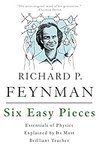
Saved by Marc Sperzel and
Six Easy Pieces

Saved by Marc Sperzel and
chloride. Strictly speaking, the crystal is not made of atoms, but of what we call ions. An ion is an atom which either has a few extra electrons or has lost a few electrons.
when they leave they take away heat; when they come back they generate heat.
This means that when we compress a gas slowly, the temperature of the gas increases. So, under slow compression, a gas will increase in temperature, and under slow expansion it will decrease in temperature.
freezing. Helium, even at absolute zero, does not freeze, unless the pressure is made so great as to make the atoms squash together. If we increase the pressure, we can make it solidify.
Another way to remember their size is this: if an apple is magnified to the size of the earth, then the atoms in the apple are approximately the size of the original apple.
The atoms are 1 or 2 × 10-8 cm in radius.
all things are made of atoms—little particles that move around in perpetual motion, attracting each other when they are a little distance apart, but repelling upon being squeezed into one another.